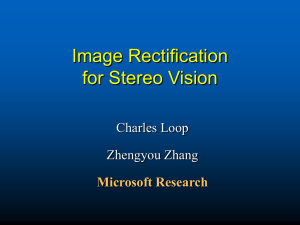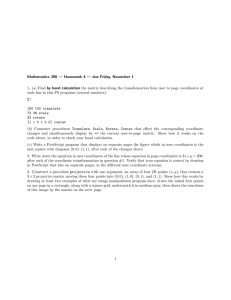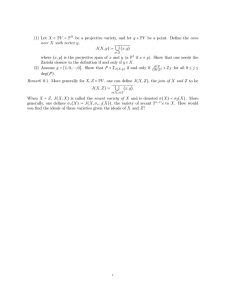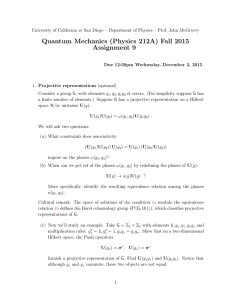OBJECT RECONSTRUCTION USING 2·D PROJECTIVE TRANSFORl)lATIONS Ilkka Niini The Academy of Finland
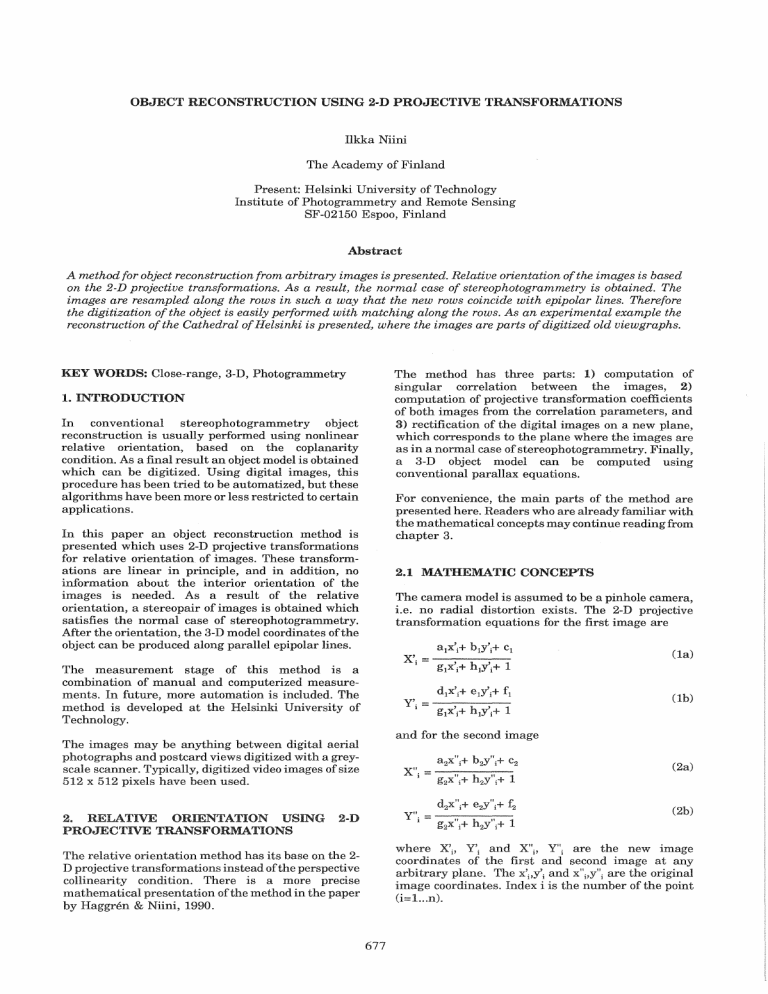
OBJECT RECONSTRUCTION USING 2·D PROJECTIVE TRANSFORl)lATIONS
Ilkka Niini
The Academy of Finland
Present: Helsinki University of Technology
Institute of Photogrammetry and Remote Sensing
SF-02150 Espoo, Finland
Abstract
A method for object reconstruction from arbitrary images is presented. Relative orientation of the images is based on the 2-D projective transformations. As a result, the normal case of stereophotogrammetry is obtained. The images are resampled along the rows in such a way that the new rows coincide with epipolar lines. Therefore the digitization of the object is easily performed with matching along the rows. As an experimental example the reconstruction of the Cathedral of Helsinki is presented, where the images are parts of digitized old viewgraphs.
KEY WORDS: Close-range, 3-D, Photogrammetry
1. INTRODUCTION
In conventional stereophotogrammetry object reconstruction is usually performed using nonlinear relative orientation, based on the coplanarity condition. As a final result an object model is obtained which can be digitized. Using digital images, this procedure has been tried to be automatized, but these algorithms have been more or less restricted to certain applications.
In this paper an object reconstruction method is presented which uses 2-D projective transformations for relative orientation of images. These transformations are linear in principle, and in addition, no information about the interior orientation of the images is needed. As a result of the relative orientation, a stereopair of images is obtained which satisfies the normal case of stereophotogrammetry.
After the orientation, the 3-D model coordinates of the object can be produced along parallel epipolar lines.
The measurement stage of this method is a combination of manual and computerized measurements. In future, more automation is included. The method is developed at the Helsinki University of
Technology.
The images may be anything between digital aerial photographs and postcard views digitized with a greyscale scanner. Typically, digitized video images of size
512 x 512 pixels have been used.
The method has three parts: 1) computation of singular correlation between the images, 2) computation of projective transformation coefficients of both images from the correlation parameters, and
3) rectification of the digital images on a new plane, which corresponds to the plane where the images are as in a normal case of stereophotogrammetry. Finally, a 3-D object model can be computed using conventional parallax equations.
For convenience, the main parts of the method are presented here. Readers who are already familiar with the mathematical concepts may continue reading from chapter 3.
2.1 MATHEMATIC CONCEPTS
The camera model is assumed to be a pinhole camera, i.e. no radial distortion exists. The 2-D projective transformation equations for the first image are
Y ' i = - - - - - glX'i+ h1y'i+ 1 and for the second image
CIa)
(lb)
(2a)
(2b)
2. RELATIVE ORIENTATION USING 2-D
PROJECTIVE TRANSFORMATIONS
The relative orientation method has its base on the 2-
D projective transformations instead of the perspective collinearity condition. There is a more precise mathematical presentation of the method in the paper by Haggren & Niini, 1990. where X'i' Y'i and Xlfi' Y"j are the new image coordinates of the first and second image at any arbitrary plane. The X'iS'i and x"i,y"i are the original image coordinates. Index i is the number of the point
(i=1..,n).
677
The condition of relative orientation is that the new
Y-coordinates are equal (Y'j= Y"J Thus:
(8b)
(3)
The original images will be projected on the same plane, and the epipolar rays become parallel with each other.
2.2 SINGULAR CORRELATION
From equation (3) a bilinear equation is obtained
(d
1 g2-g
1 d2)x'jx"j + (d
1 h 2-g
1 e2)x'iY"j +
(d1-gi2)x'j + (e1g2-h1d2)y'jx"j +
(e1h 2-h1e2)y'jy"j + (e
(f
1
-f
2)
=
0. c h 1f2)y'j +
(f1g2-d2)x"j + (f1h 2-e2)y"j +
By renaming the coefficients we obtain
(4) m1X'jX"j+m2X'jy"j+m3X'j+m4y'iX"j+ m5Y'iY"i+IllsY'j+m7x"i+mSy"j+~ = 0, which is in matrix form
(5) ffi1
IDz
~ x"
[Xl yl
1] ffi4
Ins
~ y"
=0,
~ffig~ 1 where m}
= d
1 g
2
-g
1 d
2 m 2 = d1h 2-g1e2 m3 m
4
=
= e d
1
1
-g g
2
1 f
2
-h
1 d
2 m5 = e
1 ms m7
= f
1 h
2
-h
1 e
= e
1h i2 g
2
-d
2 ms = f
1 h
2
-e
2
2
= f
1
-f
2 •
(6)
(7)
Equation (6) is also known as a correlation equation
(Thompson, 1968). This correlation is singular, so the determinant of the correlation matrix M must be zero.
According to (Jordan et.al., 1972) the determinant of the correlation matrix in the case of central perspectivity is always zero. However, the elements of the matrix M should be solved using det(M)=O as a constraint to ensure correct solution. Conventional least squares solution is used.
2.3 EPIPOLE COORDINATES
From the matrix M the epipole coordinates of both images can be obtained using the following equations: ffi
1 ffi4
I
~ Xc
IDzInsffig
I
Yc
~~IDg I
Ze
0
0
0
(8a) where x'e,y'e,z'e and x"e,y"e,z"e are homogeneous epipole coordinates of the images. Their rectangular coordinates are x'=x'jz'e' y'=y'jz'e and x"=x"jz"e' y"=y"jz"e' An approximate kappa angle of an image can be computed from the relative position of the epipole and the center of the image, assuming that the principal point is approximately at the center of the image. This property has been used later when computing the projective transformation parameters.
The projective transformation parameters for both images can be solved from the correlation matrix M, if the determinant of M is zero. There is an infinite number of solutions for the projective transformation parameters, which all lead to the same correlation matrix. Anyone of the solutions can be chosen and used in further computations, but some of them may seem to be impractical.
The relations d/e1 and h/g1 can be fixed to a chosen value which is approximately the same as the tangent of K1 (the kappa rotation along the original z-axis of image one). Then a practical solution is obtained. The above mentioned ratios are found from the comparison of the collinearity and projective transformation equations.
Any two of the elements m3, ms, m7 and ms are always nonzero, these being usually Ills and ms when the situation is near the normal case of photo gramme try.
If
I msl >
I m71 and
I msl >
I m31 , we obtain t=-y' jx'e' where t=tanK1' and y'e' x'e are the coordinates of the epipole point of image one. These can be directly computed from the correlation matrix Musing equations (8).
Choosing f1=0, the rest ofthe projective transformation parameters can be solved using equations (7), and equalities d/e1=t and h/g1=-t. When f1 gets the value of zero, it corresponds to the situation where the omega rotation of the first image is zero in the conventional collinearity equations, thus preventing the arbitrary projection plane to rotate around the eye base.
If
I msl >
I m71 and
I msl >
I m31 (the most probable case), the following expressions for the projective parameters have been derived: d
2
=
-m7 e f2 e
2
1 gl
= -ms
=
-mg
=
(m
=
(m
6
+tm
3
2
-tm
5
)/(t
2
)/(m
+1) s
(e+1» d1 = tel hI = -tg1 g2 = -(m4+g h2 = -(m
5
1 tm7)/ms
+g
1 tms)lms
(9)
678
Parameter t
= tan K
I .
The projective parameters ofYequations are then known, but the parameters of Xequations are still unknown. They might be freely chosen, but to avoid getting into troubles (getting a left-handed coordinate system), these must be computed analytically.
According to (Schmid, 1954) it is possible to use two constraints to get the reference coordinate system (in the new plane) centered in Xo=O, Yo=O, and Ho=H (H is freely chosen). The modified constraints for the first image are
(10)
The second image obtains similar equations. Using these constraints, parameters aI' bI, a
2, b
2 can be computed. Unfortunately, it leads to ambiguous signs, which have to be determined separately. In the most probable case, as mentioned before, a l has the same sign as eI, and a
2 the same sign as e
2•
Signs of b I and b
2 will then be automatically correct. The remaining two parameters,
C I and C2 in this way: can be solved for example
(11)
Equations (11) are derived from the properties of an orthogonal matrix (Schwidefsky et.al., 1976).
Equations with the bigger denominators are used.
2.4 MODEL RECONSTRUCTION
After the final rectified image coordinates have been computed and an arbitrary base length Bx has been given, the model can be reconstructed using well known parallax equations:
Y j
=
(y'j+ Y")Bx -HBx
2Pi
, Z.---
1
Pi where the X-parallax is
(12)
The 3-D coordinates are linearly deformed, because the inner orientation was not treated as an orthogonal reference. A 15-parameter projective transformation can be used in absolute orientation to transform the model to a cartesian ground system. Also knowledge oflinear object features, e.g. parallel lines, can be used to obtain orthogonal references.
3. MAIN ALGORITHM
The object reconstruction algorithm is performed in two steps: 1) rectification and 2) model digitizing.
The main idea of the method is to project the images to a plane where their epipolar lines become parallel.
U sing at least nine homolog points, 2-D projective transformations between the original images and this plane, where the rows coincide with epipolar lines, is obtained. The images are then digitally resampled on that new plane using bilinear interpolation method.
As a result, a normal case of stereophotogrammetry is obtained, where the digitizing is easily performed along the parallel epipolar rows.
3.1 RECTIFICATION
At first, the images are displayed on the graphical display instrument. Because the scale and resolution of the homolog points at different images may not be equal, the identification of the homolog points is not necessarily easy. In this case, the first rectification is only an approximate one, and new observations can be identified from these once rectified images to obtain a new rectification. Mostly only one rectification is enough. The observations for the possibly needed second rectification may be selected completely independent on the first step.
Normally, the operator uses a mouse or cursor to show at least 9 homolog points from both images, 15-30 is recommended. The observation can be determined with the cursor alone, or showing a suitable sized window, whose gradient weighted center is the actual observation. This method suits best for points and corners, whose identification is probably the easiest.
Measurement accuracy of this step depends on the orientation of the images and the measurement method. If there is a large convergency angle between the images, identification of objects is not easy, and the accuracy may be some pixels, therefore a new rectification may be necessary. If the images are near the normal case, i.e. the convergence angle is less than
20-30 gons, the measurement accuracy may be up to half a pixel, provided that the cursor measurement is used. If the method of gradient weighted center is used, a subpixel accuracy is possible.
The images are resampled using bilinear interpolation method. Only the stereo overlap area is needed to be resampled. If two rectifications are needed, the resampling is still performed using the original images, not the once rectified images. The final rectification parameters (R f ) can be computed simply by multiplying the first parameters (RI) by the second parameters (R
2), i.e. R f
= R
2
RI. These are all 3 x 3 nonsingular matrices. In this way, an unnecessary weakening of image quality is avoided. The operator can control the result of the rectification visually from the display instrument.
679
3.2 MODEL DIGITIZING
The measurements are made pointwise by measuring the left image point first, and then searching the corresponding homolog point from the right image along the current epipolar line. The left image is always measured by the user either by showing a suitable sized window, or just by showing a cursor position. The searching of the right homolog point is made automatically or by the operator, depending on the user's choice.
If automatic searching is selected, then a small window is shown on the left image, and the position of a point inside the window is computed using the method of gradient weighted center. The same window is then searched from the right image moving the window along the X-direction, and possibly some pixels in the Y-direction, depending on the rest Y-parallax of the rectification step. If movement in the Y-direction is necessary. The quick search is based on a simplified cross-correlation, and as a result the location of the right image window is found with an accuracy of at least one pixel. Finally, the actual right image observation is computed using the gradient weighted center of that window.
As the automatic search easily fails, the manual digitizing is kept as an alternative. This is made by pointing the object on the left image by cursor, then the current epipolar line is drawn on the right image, where it is now easy to show the same point with cursor. In this case, only the X-parallax is measured and Y-coordinate is kept the same on both images.
The 3-D coordinates of the object model are directly obtained from the homolog observations using parallax equations (12), a freely chosen base length (B), and the previously chosen camera constant (H).
3.3 DISCUSSION
For the moment, the implementation of the measurement stage is based on the searching of the homolog points along epipolar lines. The measurement stage can be developed so that a stereoscopic view is possible to use, but this requires also a moving measuring mark on both images and a special display instrument.
The measurement stage is mainly manual, but this is anyway the most reliable method to obtain observations of the most important object points, especially when there is a wide convergency angle between the images, and an automatical object recognition is not guaranteed to work reliably enough. Making the observational step more automatic needs further investigations. E.g. least squares image matching can be implemented, but it requires certain conditions, which cannot always be valid when using images which have large convergency angle. Also the possibility of adding more images to the system will be investigated, as well as the implementation of additional parameters for compensating nonlinear image deformation.
4. EXPERIMENTS
The object reconstruction program has been used in relative orientation of two digitized postcard images of the Cathedral of Helsinki.
The postcards were digitized using a resolution of 200 pixels/inch, and 256 grey values. Only an area of 512 x 512 pixels were used out of the original postcards.
The size of a pixel was approximately 10 cm in the object space. The extracted images are shown in figures 1a and lb.
The arbitrarily chosen camera constant was put to
2000 pixels, and the left lower corner of the image was treated as an origin. The images after the final rectification are shown in figures 2a and 2b.
Stereoscopic viewing of these images is possible if the direction of sights are crossed. 29 points were used in the computation of this final rectification, which had a standard deviation of 0.96 pixels. Measurements were made using both the cursor positioning and the gradient weighted center of a shown window.
The 3-D model was then digitized from the rectified stereo images, but it was linearly deformed. This model was compared to a cartesian model that was digitized using an analytical stereo plotter and a pair of previously photographed metric images. The geometry of the metric model was quite good
Cbase/distance-ratio was about 112), and the root mean square error (RMSE) of the digitized model coordinates was less than 2 centimeters.
A 15-parameter transformation between the deformed model and the cartesian model using 14 points gave
RMSE-values of 21 cm in X, 32 cm in Y and 22 cm in
Z, where Y was the depth direction. Also the actual base of the postcard model proved out to be only 6.7 m with an object distance of approximately 70 m, which gave a base/distance value of 0.09.
It has to be noted here that the inner orientation was completely unknown and the possibly radial distortion was still affecting in the images, which may explain the high RMSE-values.
The aim of this experiment was not to produce any precise 3-D model, but to show that the relative orientation method described in previous chapters works, and it really produces stereo images that can be used in measurements.
680
Figure 1a. Right image. Figure lb. Left
Figure 2a. Rectified right image. Figure 2b. Rectified left
REFERENCES
Haggr'en, H., Niini, 1., 1990. Relative Orientation using 2-D Projective Transformations.
Photogrammetric Journal of Finland, Vol. No.1,
1990, pp. 22-33.
Jordan, Eggert, Kneissl, 1972. Handbuch der
Vermessungskunde, Band HI ala (Photogrammetrie),
J. B. Metzlersche Verlagsbuchhandlung, Stuttgart,
1972, p. 2267.
Schmid, H., 1954. An Analytical Treatment of the
Orientation of a Photograrnmetric Camera,
OJ "',",..".-.-,' pp. 765-781. and
=-.::;;==:..====,
B.G. Teubner, t3tl.lttl!aJrt
F., 1976. pp.
40-41. of pp.
68
